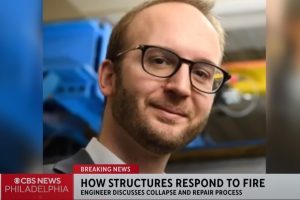
With one of the busiest sections of highway in the nation knocked out of commission, national media sought expert insights on the I-95 tanker fire and highway collapse. Thomas Gernay, assistant professor in the Department of Civil and Systems Engineering and Engineering for Professionals instructor, had them.
Not only is Gernay one of the foremost experts on the effects of fire on the built environment, he also studies the impact of critical infrastructure damage on a city’s ability to function and develops methods to minimize damage and recovery time to enhance community resiliency.
Gernay was interviewed by the New York Times, USA Today, CBS News Philadelphia, and NBC Washington to explain how a burning tanker could cause so much damage and disruption.
“These fires can exceed temperatures of 1500 F in just a few minutes,” he told USA Today. “The parts of the structure that did not collapse can be permanently damaged by the material degradation and the movements induced by the heat exposure.”
Gernay is the co-author of SAFIR®, an innovative software used by more than 250 institutions, engineers, and researchers worldwide to model accurately and predict a structure’s response to fire.
Since the start of 2023, he has been recognized with a National Science Foundation Early CAREER Award, the International Association of Fire Safety Science’s Magnusson Award, and the American Institute of Steel Construction’s Terry Peshia Early Career Faculty Award.
Adds Gernay:
“Bridges are generally not designed to withstand a severe fire. Unlike in buildings, steel girders in bridges are rarely protected with thermal insulation. As a result, with a fire directly underneath the steel structure, these steel members will heat up and weaken fast. Steel loses about half of its strength at 1100 degrees Fahrenheit, and this level of temperature can be expected with a tanker truck fire directly underneath a bridge structure.
“These accidents, while rare, are not unprecedented. In 2007, a gasoline tanker truck caught fire under a connecting ramp in Oakland, CA. The fire led to the collapse of the overhead span in about 20 minutes.
“These are low-probability but high-consequence events. The economic cost from the traffic disruption can reach tens of millions of dollars. Some bridges can be deemed particularly critical for the transportation network or of high value. For such bridges, structural fire engineers can assess the vulnerability to fire hazard and develop design solutions to mitigate the fire risk. Modeling and numerical simulation can support the fire design.”